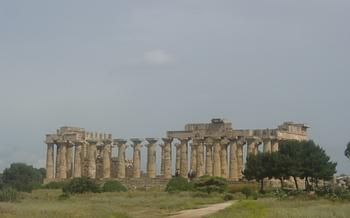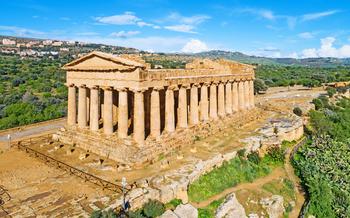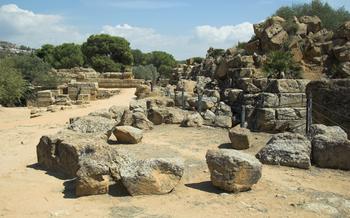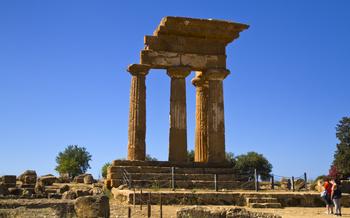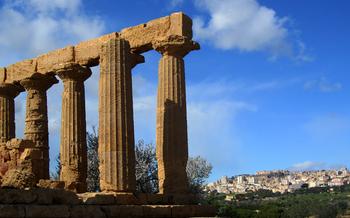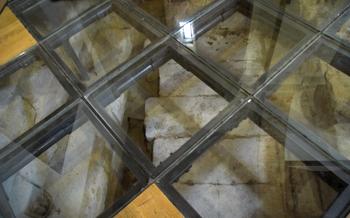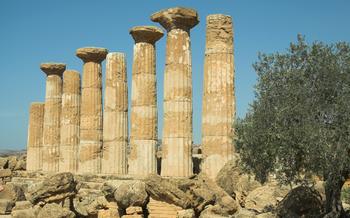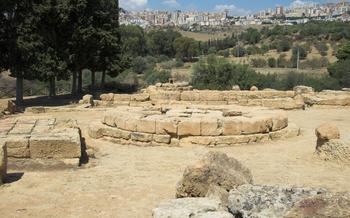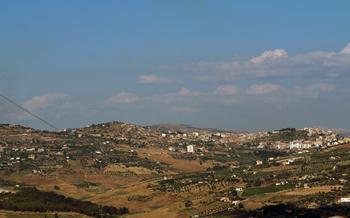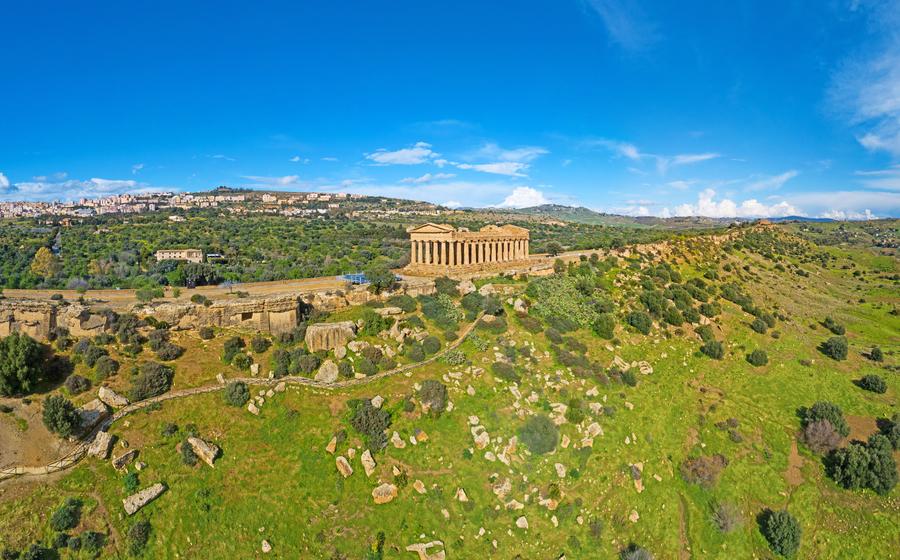
Valley of the Temples
- Agrigento's Valley of the Temples: A Journey Through History
- Historical Significance
- Temple of Concordia
- Temple of Hercules
- Temple of Zeus Olympius
- Temple of Castor and Pollux:
- Valley of the Temples Museum
- Guided Tours
- Best Time to Visit
- Admission and Tickets
- Getting There
- What to Wear
- Food and Drink
- Insider Tip: Unforgettable Sunset Experience
Agrigento's Valley of the Temples: A Journey Through History
In the heart of Sicily, nestled amid rolling hills and picturesque landscapes, lies the ancient city of Agrigento. Once a powerful Greek colony known as Akragas, Agrigento is renowned for its awe-inspiring Valley of the Temples, a UNESCO World Heritage Site that transports visitors back in time to the golden age of Hellenic civilization. Step into this remarkable archaeological park, and you'll be greeted by an array of well-preserved ancient Greek temples, each with its unique story to tell. Prepare to be captivated as we embark on a journey through history, discovering the secrets and significance of the Valley of the Temples, a testament to the enduring legacy of ancient Greece.
Historical Significance
The Valley of the Temples is a testament to the ancient Greek civilization's influence on Sicily. Founded by Greek colonists in the 6th century BC, Agrigento became one of the most important cities in the Magna Graecia, a region of southern Italy and Sicily where Greek culture and language flourished.
The temples, built over several centuries, were dedicated to various Greek deities and played a significant role in religious ceremonies and festivals. The well-preserved remains of these temples offer a glimpse into the ancient Greek architectural style, with their imposing columns, intricate carvings, and harmonious proportions.
In 1997, the Valley of the Temples was declared a UNESCO World Heritage Site, recognizing its outstanding universal value as a cultural landmark. It continues to attract visitors from around the world who come to admire the architectural masterpieces and learn about the rich history of this ancient Greek city.
Temple of Concordia
Among the many architectural wonders of the Valley of the Temples, the Temple of Concordia stands out as a testament to the enduring legacy of ancient Greek architecture. Constructed in the 5th century BC, this Doric-style temple is remarkably well-preserved, boasting a majestic façade with six fluted columns on each side and thirteen columns on each of the longer sides. Its harmonious proportions and elegant lines have earned it the distinction of being one of the best-preserved ancient Greek temples in the world, captivating visitors with its architectural prowess.
Step through the grand entrance and marvel at the temple's interior, which once housed a colossal statue of Zeus. The cella, or inner chamber, features a series of columns that divide the space into three naves, creating a sense of grandeur and awe. Admire the intricate details of the capitals, adorned with sculpted acanthus leaves, and the remnants of the pediments, which once displayed elaborate scenes from Greek mythology.
The Temple of Concordia is not merely a historical relic but a symbol of the enduring power of art and architecture. Its exceptional state of preservation offers a rare glimpse into the architectural achievements of the ancient Greeks, transporting visitors back in time to witness their mastery of design and construction.
Temple of Hercules
Among the impressive structures that grace the Valley of the Temples, the Temple of Hercules stands out for its grandeur and historical significance. Constructed in the 6th century BC, it is one of the oldest temples in the valley and is believed to have been dedicated to the mythical hero Hercules, known for his extraordinary strength and numerous adventures.
The temple's immense size is awe-inspiring, with its massive columns towering over the surrounding landscape. Originally consisting of 38 columns, each measuring an astonishing 10 meters in height, only nine of these colossal columns remain standing today. Despite the ravages of time and natural disasters, the Temple of Hercules retains its majestic presence, captivating visitors with its sheer scale and architectural prowess.
While the exact purpose of the temple remains shrouded in mystery, its prominent location suggests that it played a significant role in the religious and civic life of ancient Agrigento. Historians speculate that the temple was used for religious ceremonies, public gatherings, or even as a meeting place for the city's leaders.
As you approach the Temple of Hercules, take a moment to admire the intricate carvings that adorn its well-preserved columns. These intricate decorations, depicting mythological scenes and figures, offer a glimpse into the artistic and cultural heritage of ancient Greece. The temple's enduring legacy as a symbol of strength and resilience continues to inspire visitors, making it a must-see destination in the Valley of the Temples.
Temple of Zeus Olympius
The Temple of Zeus Olympius, the largest and most imposing structure in the Valley of the Temples, is a testament to the grandeur and ambition of ancient Greek architecture. Although unfinished, its sheer size and architectural features still awe visitors today.
Erected in the 5th century BC, the temple was dedicated to Zeus, the king of the Olympian gods. Its massive dimensions reflect the importance and reverence accorded to Zeus. The temple stands on an elevated platform, accessible by a monumental staircase, adding to its grandeur and imposing presence.
Despite its unfinished state, the temple's architectural elements are impressive. The remains of the temple reveal its colossal size, with a rectangular base measuring 113 meters in length and 56 meters in width. The temple was designed as a Doric temple, featuring fluted columns and a triangular pediment adorned with sculptures.
Although many of the columns and sculptures have been lost or damaged over time, the remaining elements still convey the temple's original majesty. Visitors can admire the massive columns, each standing over 17 meters tall, and appreciate the intricate details and craftsmanship that went into their construction.
The Temple of Zeus Olympius, with its unfinished grandeur, stands as a reminder of the ambition and architectural achievements of the ancient Greeks. Its impressive size and architectural features continue to inspire awe and provide a glimpse into the grandeur of ancient Greek civilization.
Temple of Castor and Pollux:
Among the temples that adorn the Valley of the Temples in Agrigento, Sicily, the Temple of Castor and Pollux holds a significant place. Dedicated to the twin gods of Greek mythology, Castor and Pollux, this temple stands as a testament to the ancient Greek influence that shaped the region.
Although the temple has faced the ravages of time, its remnants still convey its architectural prowess and historical importance. Four well-preserved columns rise majestically, offering a glimpse into the grandeur of the original structure. These columns, along with fragments of the entablature and pediments, provide valuable insights into the temple's design and construction.
The Temple of Castor and Pollux played a pivotal role in the religious and civic life of ancient Akragas. It served as a place of worship and a venue for public gatherings and celebrations honoring the twin gods. Castor and Pollux were revered for their heroic deeds, particularly their intervention in the Battle of Lake Regillus, where they are said to have aided the Romans to victory.
Visiting the Temple of Castor and Pollux is like stepping back in time, allowing visitors to connect with the rich mythology and history that permeated ancient Greek culture. The temple's enduring presence, despite the passage of centuries, serves as a reminder of the enduring legacy of this ancient civilization.
Valley of the Temples Museum
The Valley of the Temples Museum is a must-visit destination for anyone interested in delving deeper into the history and significance of the site. Located within the archaeological park, the museum houses a rich collection of artifacts, sculptures, and other relics excavated from the Valley's temples and surrounding areas.
The museum's exhibits are arranged chronologically, taking visitors on a journey through the different periods of Agrigento's ancient past. Highlights include the Telamone, monumental stone figures that once adorned the Temple of Zeus Olympius; the Ephebe of Agrigento, a stunning bronze statue of a young athlete; and the Demeter of Agrigento, a beautiful marble sculpture of the goddess of agriculture.
In addition to its permanent collection, the museum also hosts temporary exhibitions and educational programs. Visitors can learn about the latest archaeological discoveries, attend lectures by experts in the field, and participate in hands-on workshops.
The Valley of the Temples Museum is a valuable resource for anyone who wants to gain a deeper understanding of this remarkable ancient site. It is a place where history comes alive, and the spirit of ancient Greece can still be felt.
Guided Tours
To fully appreciate the historical, cultural, and mythological significance of the Valley of the Temples, it's highly recommended to take a guided tour. Led by knowledgeable and passionate guides, these tours provide in-depth insights into the architecture, history, and religious beliefs of ancient Greece.
Guides will lead you through the various temples, explaining their construction, purpose, and the myths and legends associated with them. They'll point out architectural details, such as the elegant Doric columns, elaborate friezes, and intricate sculptures, which often go unnoticed to the untrained eye.
By weaving together historical facts, mythological tales, and archaeological discoveries, guides bring the Valley of the Temples to life, painting a vivid picture of what life was like in ancient Akragas. They'll share stories of the gods and goddesses worshipped here, the rituals and ceremonies performed, and the bustling life that once filled these sacred grounds.
Whether you're a history buff, an archaeology enthusiast, or simply someone who appreciates the beauty and grandeur of ancient architecture, a guided tour will undoubtedly enhance your experience of the Valley of the Temples.
Best Time to Visit
The best time to visit the Valley of the Temples is during the shoulder seasons, spring (March-May) and autumn (September-November), when the weather is pleasant and the crowds are smaller. Summer months (June-August) can be hot and crowded, especially during July and August when temperatures can soar and the site is packed with tourists. Winter months (December-February) can be chilly and rainy, with occasional closures due to weather conditions.
If you are looking for a truly unforgettable experience, consider visiting the Valley of the Temples at sunset. As the sun dips below the horizon, the ancient ruins are bathed in a warm golden light, creating a magical and serene atmosphere. It is the perfect time to appreciate the beauty and grandeur of these ancient structures and to reflect on their historical significance.
Admission and Tickets
Visiting the Valley of the Temples requires an admission ticket, the proceeds of which contribute to the preservation and maintenance of this remarkable archaeological site. The ticket grants access to the entire Valley of the Temples, including all the temples and the museum. Several ticket options are available to meet different needs and budgets.
The standard admission ticket, which costs around €12, provides access to the Valley of the Temples and the museum for one day. For those interested in a more in-depth experience, the Valley of the Temples also offers a combined ticket that includes admission to the Kolymbethra Garden, a botanical garden and archaeological site located near the Valley of the Temples. The combined ticket costs around €15 and allows for two consecutive days of access.
Discounts on admission fees are available for various categories of visitors, such as students, seniors, and families. Children under the age of 5 are admitted free of charge. It is advisable to purchase tickets online in advance, as this allows visitors to skip the line at the ticket office, especially during peak season. Online tickets are available on the official website of the Valley of the Temples.
Getting There
Reaching the Valley of the Temples is a straightforward process, with various transportation options available. If you're coming from nearby cities like Palermo or Catania, you can take advantage of the well-connected train network. Trains depart regularly from these cities and offer a scenic journey through the picturesque Sicilian countryside. Once you arrive at the Agrigento Centrale train station, you can hop on a local bus that will take you directly to the Valley of the Temples.
For those who prefer a more flexible and convenient option, renting a car is a great choice. With a car, you can enjoy the freedom to explore the Valley of the Temples at your own pace and visit other nearby attractions, such as the Scala dei Turchi, a stunning white cliff formation, or the charming town of Sciacca, famous for its thermal baths.
No matter which mode of transportation you choose, make sure to plan your journey in advance, especially if you're visiting during the peak tourist season. Arriving early in the morning or late afternoon is advisable to avoid the midday heat and crowds.
What to Wear
When preparing for your visit to the Valley of the Temples, it's crucial to consider the warm climate and uneven terrain of the site. To ensure a comfortable and enjoyable experience, prioritize lightweight, breathable clothing made from natural materials like cotton or linen. Avoid heavy fabrics that can trap heat and cause discomfort.
In terms of footwear, opt for sturdy and comfortable shoes with good traction. The uneven surfaces and cobblestone paths require proper support and stability to prevent any accidents or discomfort. Avoid wearing sandals or flip-flops, as they can be hazardous on the uneven terrain.
Sun protection is also essential. Pack a hat and sunglasses to shield yourself from the intense sunlight, especially during the summer months. Additionally, consider bringing a light scarf or shawl to protect your shoulders and neck from the sun and the occasional cool breeze.
By dressing appropriately for the Valley of the Temples, you can fully immerse yourself in the ancient wonders without sacrificing your comfort and safety. Embrace the Mediterranean style with light, airy clothing and sturdy footwear, and don't forget your sun protection essentials.
Food and Drink
After a day of exploring the ancient ruins, satisfy your appetite with delicious local cuisine. Just outside the Valley of the Temples, you'll find several trattorias and restaurants serving authentic Sicilian dishes. Indulge in fresh seafood, homemade pasta, and mouthwatering desserts.
For a truly unforgettable dining experience, make a reservation at one of the restaurants with a view of the Valley. As you savor your meal, let your gaze wander across the majestic ruins, bathed in the warm glow of the setting sun. It's a magical moment that will stay with you long after your visit.
Some local specialties you must try are pasta alla Norma, made with eggplant, tomato sauce, and ricotta salata cheese; arancini, deep-fried rice balls filled with meat sauce and peas; and cannoli, crispy pastry shells filled with a sweet, creamy ricotta filling.
Insider Tip: Unforgettable Sunset Experience
For an unforgettable experience, visit the Valley of the Temples at sunset. As the sun dips below the horizon, the ancient ruins are bathed in a magical golden light, casting long shadows and creating a breathtaking atmosphere. The warm glow illuminates the intricate details of the temples, making them appear even more majestic and awe-inspiring. Take this opportunity to capture some stunning photographs and soak in the serene ambiance as the Valley transforms into a picturesque masterpiece. Whether you're a history buff, an architecture enthusiast, or simply someone who appreciates beauty, witnessing the Valley of the Temples at sunset is an experience that will stay with you long after your visit.
